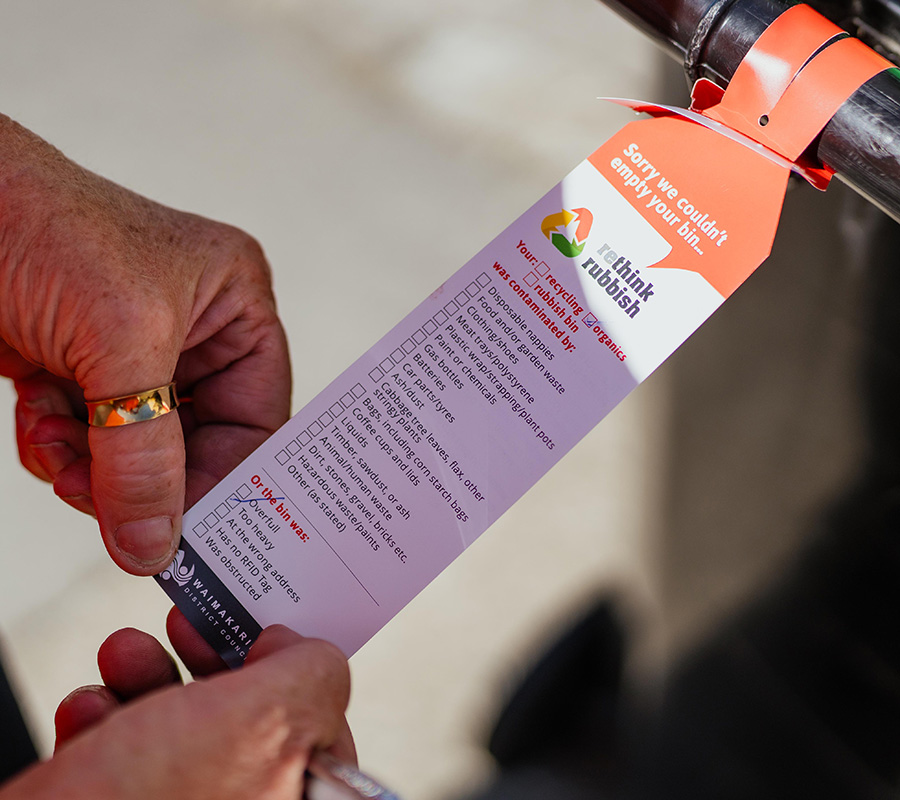Meet Leanne, one of five kerbside collection truck drivers working in Waimakariri for WM New Zealand, the contractor for Council’s kerbside collection scheme.
Leanne’s been in the job more than 15 years now and just loves being out there, serving her community.
“What I enjoy most about my job is that every day’s a challenge, every run’s a challenge, every bin’s a challenge.”
Our collection truck drivers have a busy job to do, collecting around 5,000 Council bins and bags in the District each week. Leanne knows a thing or two about bins – what goes in them and what shouldn’t, and where and how to place them on your kerbside.
So, to help Leanne with her daily run, and to ensure your household waste doesn’t risk being missed, here are some reminders when it comes to your rubbish, recycling, and organics.
Bins out before 7am
Leanne has an early start, arriving for work at 6.30am before what can sometimes be an 11-hour shift. She has half an hour to plan her day with the other drivers, discuss potential issues and run through prestart checks on her vehicle before starting her collections at 7am.
Despite the reminders for people to put their bins out by 7am, Leanne says many people still forget.
“We do see a lot of people – they can hear the truck and then run out with their bins but it might be down the road already or whatever. Then they ring up and complain that their bin wasn’t collected. The easiest way to avoid this is put your bin out before 7am.”
Once your bins have been emptied, bring them back in as soon as you can, to avoid them being blown over, especially on windy days.
Getting the right items into the right bin
Since the new national standards to kerbside collection came into place in February, there have been some changes to what items Waimakariri residents can put into each bin.

You can view all the changes here but the main ones are:
- Clean pizza boxes without food scraps now go in the recycling (dirty pizza boxes go in the rubbish)
- Shredded paper, serviettes and paper towels now go in the rubbish
- Tea bags now go in the rubbish
- Aerosol cans now go in the rubbish
- Plastic containers and bottles up to four litres, but no smaller than a yoghurt pottle now go in the recycling.
 Aside from residents trying to adjust to the changes, the common bin sins that Leanne continues to find are in people’s recycling bins. The main culprits are lids (from jars and containers), takeaway coffee cups and soft plastics. These items, alongside tetra paks (juice and milk cartons) and polystyrene, can’t be recycled.
Aside from residents trying to adjust to the changes, the common bin sins that Leanne continues to find are in people’s recycling bins. The main culprits are lids (from jars and containers), takeaway coffee cups and soft plastics. These items, alongside tetra paks (juice and milk cartons) and polystyrene, can’t be recycled.
Leanne has seen some dire recycling bins during her time and on an average day is forced to reject up to 40 of them.
Rather than contaminate a truck load of clean recycling, she will leave a note for the bin user to explain why she can’t collect their bin and which items need to go either into the rubbish or the organics bin.
Leanne will tie an auditing tag to the bin handle, which is then recorded onto a contamination app used by both drivers and bin auditors, so the Council can identify any trends. She says she’s happy to chat this through with people if they have questions.
“I don’t mind if people come out and discuss why I’m writing this down. It’s all part of educating people on what’s right and what’s wrong.”
Placing bins correctly on the kerbside
Not everyone can manoeuvre a heavy truck through narrow streets laden with parked cars, but Leanne makes it seem like a breeze.
The biggest obstacle for Leanne, however, is hard-to-reach bins or bags that she must manually readjust.
“It’s getting more and more difficult getting in and out of the truck [to move bins] – say a hundred times a day.”
To help Leanne and the other drivers safely reach your bins, please place them half a metre from other bins and one metre clear of poles, mailboxes and parked cars. This gives the truck’s robotic arm enough room to clasp onto and pick up each bin. The robotic arm has a maximum weight limit of 70kg, so instead of over-filling your bin, consider taking your excess waste to your local transfer station.
If you use Council rubbish bags or smaller bins, make sure the driver can see them. It’s best to place these items before your larger bins if they’re in a row.

Sparing a thought for the truck driver
A little bit of consideration for our kerbside collection truck drivers, and the often-unpredictable environment they operate in, goes a long way to ensuring your household waste gets successfully collected each week.
Leanne wants to remind everyone that even though she’s a truck driver, she’s still human.
“I still have my rules and regulations as well. I’m trying to keep it safe for everybody – the community, the people, and the vehicles around me.
“I’m just doing my job the best I can, really.”


